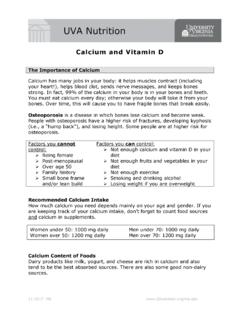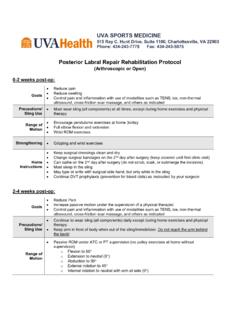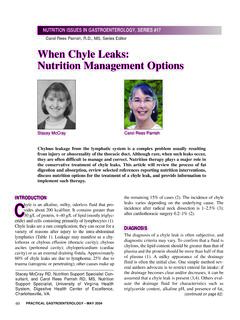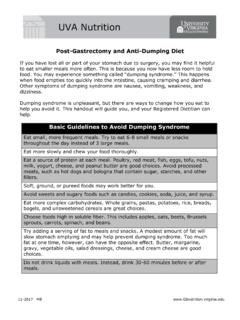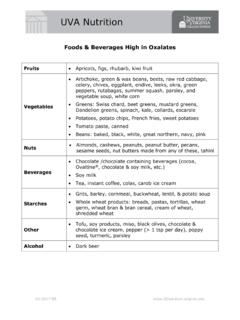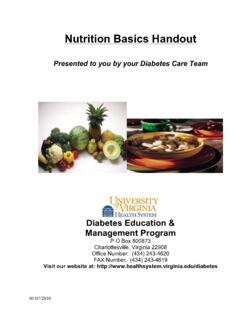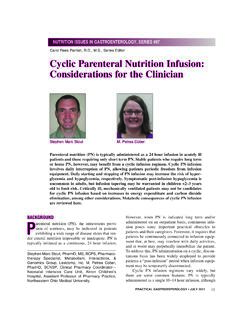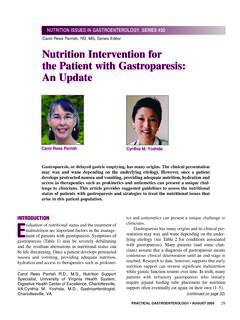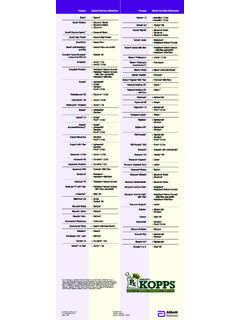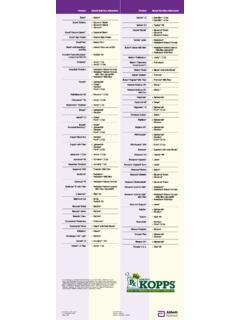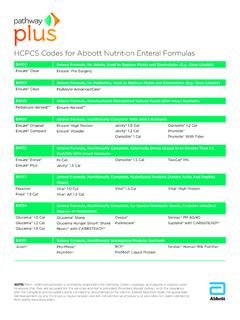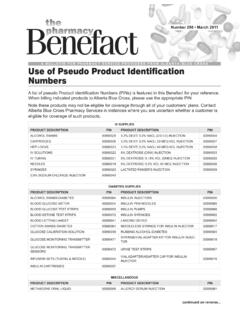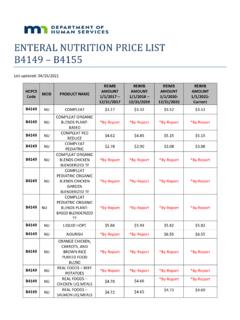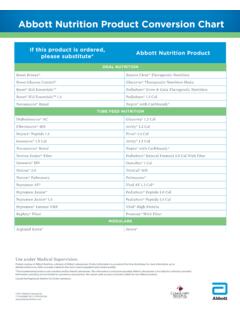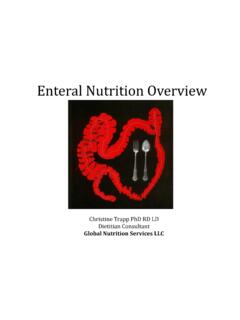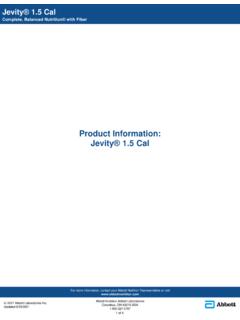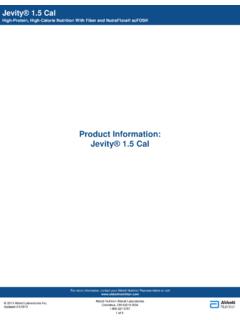Transcription of Carol Rees Parrish, R.D., MS, Series Editor Enteral ...
1 PRACTICAL GASTROENTEROLOGY JUNE 200544 INTRODUCTIONIn the last 25 years the number and variety of enteralformulas that are available for use has increased dra-matically. Well over 100 Enteral formulas are nowavailable, making formula selection rather addition, Enteral formulas are considered food sup-plements by the Food and Drug Administration (FDA)and are therefore not under the same regulatory controlas medications. As a result, Enteral formula labels maymake structure and function claims without priorFDA review or approval.
2 Furthermore, there is a lackof prospective, randomized, controlled clinical trialssupporting the purported indications for the majority ofthe specialized formulas currently on the market. Enteral formulas may be classified as standard,elemental or specialized. Many formulas are availablewithin each category, often containing significant dif-ferences in nutrient composition. Standard Enteral for-mulas are defined as ones with intact protein contain-ing balanced amounts of macronutrients and will oftenmeet a patient s nutrient requirements at significantlyless cost than specialized formulas (See Table 1 forEnteral Formula Selection: A Review of Selected Product CategoriesNUTRITION ISSUES IN GASTROENTEROLOGY, Series #28 Carol Rees Parrish, , MS, Series EditorAinsley M.)
3 Malone, MS, RD, LD, CNSD, Mt. CarmelWest Hospital, Department of Pharmacy, Columbus, availability of specialized Enteral formulas has burgeoned in the last 20 years,many touting pharmacologic effects in addition to standard nutrient delivery. Enteralformulas have been developed for many specific conditions including: renal failure,gastrointestinal (GI) disease, hyperglycemia/diabetes, liver failure, acute and chronicpulmonary disease and immunocompromised states.
4 Elemental and fiber supple-mented formulas are also frequently recommended for use in those with certain typesof gastrointestinal dysfunction. This article will review the rationale for use of special-ized formulas, provide the supportive evidence, if available, and provide suggestions forclinical application. Ainsley Malone(continued on page 46) PRACTICAL GASTROENTEROLOGY JUNE 200546 Enteral Formula SelectionNUTRITION ISSUES IN GASTROENTEROLOGY, Series #28commonly used products). Specialized formulas aredesigned for a variety of clinical conditions or diseasestates.
5 There are over thirty-five specialized formulascurrently on the market. The purpose of this article isto review the rationale behind specialized formulas,provide supportive evidence, if available, and to fur-nish suggestions for clinical application. Enteral for-mulas for common food allergies as well as homemadeblenderized formulas are also discussed. Elementaland immune-modulated formulas will be reviewed infuture issues of Practical Gastroenterology. STANDARD FORMULASS tandard formulas comprise the Enteral product cate-gory most often used in patients requiring tube feed-ings.
6 Their nutrient composition is meant to match thatrecommended for healthy individuals. Table 2 pro-vides a comparison of nutrient sources in polymericand hydrolyzed products. Calorie Dense ProductsNutrient concentrations of standard formulas varyfrom kcal/mL and products may or may notcontain fiber. These formulas may be used with vol-ume sensitive patients or patients needing fluid restric-tion. Such conditions may include congestive heartfailure, renal failure or syndrome of inappropriatediuretic hormone (SIADH).
7 However, this interventionmay not always be clinically significant (Table 3). Forexample, if a patient requires 1800 kcal/day, changinga calorie/mL to a product wouldreduce the water content by 900 mL, but to change apatient from a to a kcal/mL product representsa mere 300 mL difference per 24 hour period. Calori-cally dense formulas are most practical for use inpatients requiring nocturnal and/or bolus feeding. FIBER SUPPLEMENTED FORMULASP roposed Rationale for UseDietary fiber is defined as a structural and storagepolysaccharide found in plants that are not digested inthe human gut (1).
8 Sources of fiber in Enteral formulasinclude soluble and insoluble (1). A recent fiber addi-tion to selected formulas (Ross products) is fruc-tooligosaccharides (FOS). FOS are defined as short-chain oligosaccharides and, similar to other dietaryfibers, are rapidly fermented by the colonic bacteria toshort-chain fatty acids (SCFA). SCFA influence gas-trointestinal function through several provide an energy source for colonocytes,increase intestinal mucosal growth and promote waterand sodium absorption (2).
9 Table 4 provides a listingof Enteral formulas and their fiber content. Fiber can be classified by its solubility in fibers, such as pectin and guar, are fermentedby colonic bacteria providing fuel for the colonocyte,as described above (1). In addition, increased colonicsodium and water absorption have been demonstratedwith soluble fiber, a potential benefit in the treatmentof diarrhea associated with EN (2). Insoluble fiber,such as soy polysaccharide, increases fecal weight,thereby increasing peristalsis and decreasing fecaltransit time (1).
10 (continued from page 44)Table 1 Cost Comparison of Commonly Used Standard FormulasCost/ Enteral Formula1000 Kcals ($)* cal/mLFibersource cal/mLIsosource cal/mLDeliver *Based on 1-800 Company Home Delivery Numbers (see Table 17)(continued on page 48)PRACTICAL GASTROENTEROLOGY JUNE 200548 Enteral Formula SelectionNUTRITION ISSUES IN GASTROENTEROLOGY, Series #28 Historically, soluble fiber has been difficult to addto Enteral formulas due to its viscous nature. Manyearly fiber supplemented Enteral formulas, therefore,contained soy polysaccharide as their primary fibersource.

